
Mozzarella is a semi-soft non-aged cheese prepared by the pasta filata ('stretched-curd') method with origins from southern Italy.
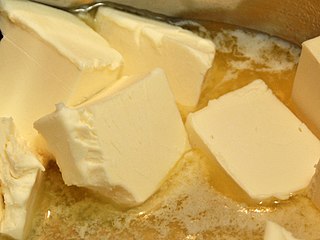
Butter is a dairy product made from the fat and protein components of churned cream. It is a semi-solid emulsion at room temperature, consisting of approximately 80% butterfat. It is used at room temperature as a spread, melted as a condiment, and used as a fat in baking, sauce-making, pan frying, and other cooking procedures.
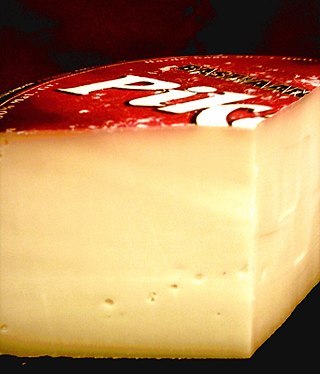
Gouda cheese is a creamy, yellow cow's milk cheese originating from the Netherlands. It is one of the most popular and produced cheeses worldwide. The name is used today as a general term for numerous similar cheeses produced in the traditional Dutch manner.

Caraway, also known as meridian fennel and Persian cumin, is a biennial plant in the family Apiaceae, native to western Asia, Europe, and North Africa.
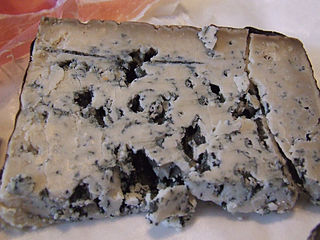
Cabrales is a blue cheese made in the artisan tradition by rural dairy farmers in Asturias, Spain. This cheese can be made from pure, unpasteurized cow’s milk or blended in the traditional manner with goat and/or sheep milk, which lends the cheese a stronger, spicier flavor.
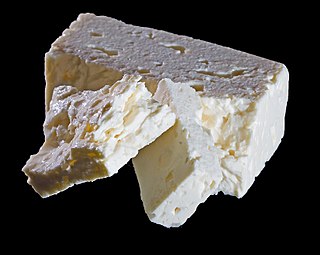
Feta is a Greek brined white cheese made from sheep milk or from a mixture of sheep and goat milk. It is soft, with small or no holes, a compact touch, few cuts, and no skin. Crumbly with a slightly grainy texture, it is formed into large blocks and aged in brine. Its flavor is tangy and salty, ranging from mild to sharp. Feta is used as a table cheese, in salads such as Greek salad, and in pastries, notably the phyllo-based Greek dishes spanakopita "spinach pie" and tyropita "cheese pie". It is often served with olive oil or olives, and sprinkled with aromatic herbs such as oregano. It can also be served cooked, as part of a sandwich, in omelettes, and many other dishes.
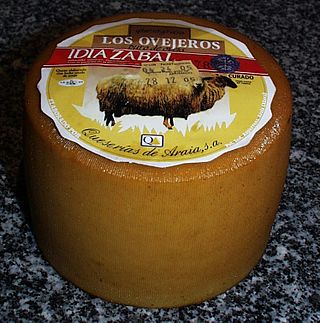
Idiazabal is a pressed cheese made from unpasteurized sheep milk, usually from Latxa and Carranzana sheep in the Basque Country and Navarre regions of Spain. It has a somewhat smokey flavor, but is usually un-smoked.

Processed cheese is a product made from cheese mixed with an emulsifying agent. Additional ingredients, such as vegetable oils, unfermented dairy ingredients, salt, food coloring, or sugar may be included. As a result, many flavors, colors, and textures of processed cheese exist. Processed cheese typically contains around 50 to 60% cheese and 40 to 50% other ingredients.

Dutch cuisine is formed from the cooking traditions and practices of the Netherlands. The country's cuisine is shaped by its location on the fertile Rhine–Meuse–Scheldt delta at the North Sea, giving rise to fishing, farming, and overseas trade. Due to the availability of water and flat grassland, the Dutch diet contains many dairy products such as butter and cheese. The court of the Burgundian Netherlands enriched the cuisine of the elite in the Low Countries in the 15th and 16th century, so did in the 17th and 18th century colonial trade, when the Dutch ruled the spice trade, played a pivotal role in the global spread of coffee, and started the modern era of chocolate, by developing the Dutch process chocolate.

Blue cheese is any of a wide range of cheeses made with the addition of cultures of edible molds, which create blue-green spots or veins through the cheese. Blue cheeses vary in taste from very mild to strong, and from slightly sweet to salty or sharp; in colour from pale to dark; and in consistency from liquid to hard. They may have a distinctive smell, either from the mold or from various specially cultivated bacteria such as Brevibacterium linens.

Maytag blue cheese is produced on the Maytag Dairy Farms just outside of Newton, Iowa city limits.

Danablu, often marketed under the trademark Danish Blue Cheese within North America, is a strong, blue-veined cheese. This semi-soft creamery cheese is typically drum- or block-shaped and has a yellowish, slightly moist, edible rind. Made from full fat cow's milk and homogenized cream, it has a fat content of 25–30% and is aged for eight to twelve weeks.
Nøkkelost is a common, Norwegian name for kuminost, a cheese flavored with cumin and cloves. It is semi-hard, yellow, and made from cow's milk, in the shape of wheels or blocks, with a maturation period of three months.

Bergkäse refers to a number of varieties of cheese produced in the Alps. This includes products of mountain farming, the cultivation of alpine pastures as well as the milk processing of local producers in dairies. The term does not say much about the type or production method of the product called mountain cheese, which is usually a hard or semi-hard cheese with no or little holes, usually with a natural rind, but there are also semi-hard cheeses and soft cheeses under this designation. The term is used also generically for Swiss-type or Alpine cheeses, which resemble these in taste and texture but do not come from one of the traditional cheese making regions. The texture is rather hard, sometimes with small holes or cracks, the flavour strong and often a bit nutty.

Cheese is a type of dairy product produced in a range of flavors, textures, and forms by coagulation of the milk protein casein. It comprises proteins and fat from milk. During production, milk is usually acidified and either the enzymes of rennet or bacterial enzymes with similar activity are added to cause the casein to coagulate. The solid curds are then separated from the liquid whey and pressed into finished cheese. Some cheeses have aromatic molds on the rind, the outer layer, or throughout.
Nagelkaas, also called Frisian Clove cheese, is an unprotected name variant of kanterkaas, a Dutch cheese developed in the Frisian Islands of the Netherlands. It is a firm-textured gouda-style cheese made from skim pasteurized cow's milk. Its 23% butterfat content results in a mild flavor, which is augmented with the addition of cloves and cumin for a pronounced spicy taste.

Vegan cheese is a category of non-dairy, plant-based cheese analogues. Vegan cheeses range from soft fresh cheeses to aged and cultured hard grateable cheeses like plant-based Parmesan. The defining characteristic of vegan cheese is the exclusion of all animal products.
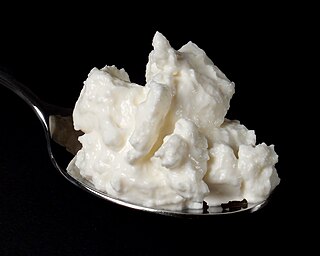
Quark or quarg is a type of fresh dairy product made from milk. The milk is soured, usually by adding lactic acid bacteria cultures, and strained once the desired curdling is achieved. It can be classified as fresh acid-set cheese. Traditional quark can be made without rennet, but in modern dairies small quantities of rennet are typically added. It is soft, white and unaged, and usually has no salt added.
















